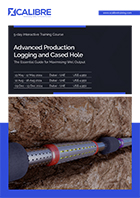| Date | Venue | Fee | |
|---|---|---|---|
| 11 May - 15 May 2026 | Dubai – UAE | $ 5,950 | Register Now |
| 10 Aug - 14 Aug 2026 | Dubai – UAE | $ 5,950 | Register Now |
| 07 Dec - 11 Dec 2026 | Dubai – UAE | $ 5,950 | Register Now |
About the Course
This 5-day interactive Advanced Production Logging and Cased Hole training course will cover a wide range of knowledge in production logging topics with a particular focus on PLT measurement tools and interpretation in addition to basics of conformance techniques and tracer technologies. It instils the delegates on the use and limitations of various production logging tools, including spinner, temperature, noise, fluid injections, and other tools. They will learn what results these tools yield, the interpretation assumptions that are integral to their designs, and how quality is affected by the acquisition process. Delegates will also acquire the fundamentals of production log interpretation with hands-on examples and an in-class workshop on interpreting single and two-phase flow using production logs. They will learn how the production logs can be used to measure 3-phase fluid flow.
Likewise, it will also illustrate some theoretical classroom sessions, providing a combination of presentations and animations. The delegates will then have practical examples by workshop exercises during the programme. It will touch on fundamentals of E&P companies’ lifecycle, addressing basic concepts of geology, reservoir-engineering concepts (e.g. field development plans, steady state & unsteady state flow, good water and bad water), petroleum engineering concepts (nodal analysis, IPR & OPR, flow regimes, and formation damage).
Core Objectives
The delegates will achieve the following objectives:
- Know the use of production logs to measure two-phase flow rates (water/oil, oil/gas, water/gas) and three-phase flow rates
- Understand the use of production logs to determine the productivity index (PI) of oil wells and the injectivity of water wells, zone by zone
- Evaluate casing integrity and cement-casing bond using the production logs
- Monitor reservoir development during production using time-lapse logs
- Identify and quantify interzone crossflow
- Develop the skills to design and implement production logging programs to optimise well performance and maximise recovery
Training Approach
This training course will be conducted through classroom or virtual training in interactive and practical methods. There will be daily individual exercises, and everyone will get an opportunity to discuss their issues with the software or with the concept itself. There will be a PowerPoint Presentation to capture all notes and explain everything in detail, and a daily recap will be provided for maximum benefit for the delegates.
The Attendees
This training course is designed for professionals who have a basic understanding of production and cased hole logging and are interested in learning more advanced techniques and applications. It is also open to anyone interested in learning more about advanced production logging and cased hole logging.
Likewise, it will be valuable to the professionals but not limited to the following:
- Reservoir Engineers
- Petroleum Engineers
- Development Geologist
- Field Engineers
- Production Managers
- Field Managers
- Oil Field Technical Staff
- Production Technologists
- All Individuals involved in the area of Production Logging
Daily Discussion
DAY ONE: FUNDAMENTALS OF RESERVOIR ENGINEERING AND VELOCITY MEASUREMENT
- Overview
- How to increase hydrocarbon production and ultimate recovery?
- E&P Companies
- Basic Reservoir Properties
- Well Performance
- Reservoir Heterogeneity
- Resource Management
- Good Water and Bad Water
- Nodal Analysis
- Flow Regimes
- IPR and OPR
- Applications of Production Logging
- Velocity Measurements
- Principles of Spinner Flowmeter
- Spinner Types and Version
- Spinner Response
- Velocity Calculation
- Spinner Reversal
- Deviation Impact
- Two-Phase Flow Overview
DAY TWO: PVT CALCULATIONS AND FLUID IDENTIFICATION TOOLS AND MEASUREMENTS
- What are PVT properties?
- Inaccuracy of PVT data and PLT Interpretation
- Fluid Identification and Measurements
- Casing Collar Locator (CCL)
- Production Gamma Ray (PGR)
- Quartz Pressure Sensor (QPS)
- Platinum Resistance Temperature (PRT)
- Fluid Density
- Capacitance Tools
- Deviated Wells and Noise Log
- Stationary Flow Measurements
- Fluid Identification Sensor
- Temperature Log
- Noise Log
- Oxygen Activation/Water Flow
- Hold-up Measurements
- Hold up from Density
- Friction Effect on Gradiomanometer
- Digital Entry Flowmeter Tool (DEFT)
- Dual DEFT
- Gas Hold-up Optical Sensor Tool (GHOST)
- Pulsed Neutron Log Tool (PNL)
- Mobile Capacitance Flow Meter (MCFM) – POLARIS Tool
- FloScan Imager (FSI)
- MAPS
- Challenges in Horizontal Wells
DAY THREE: PRODUCTION LOGGING INTERPRETATION, JOB PREPARATION, AND RESERVOIR CONFORMANCE
- Interpretation using the Slippage Model
- Determination of Hold-up
- Determination of Slippage Velocity
- Vertical Wells vs Deviated Wells
- Two Phase: Oil-water and Gas-liquid
- Using Correlations
- Job Planning and Preparation
- Safety First
- Objective
- Well Completion
- Well Pressure
- Tool Selection
- Deployment Mechanisms
- Typical PL Program
- Water Conformance
- Mechanical Treatments
- Chemical Treatments
- Diagnostic Tools
- Polymer Gels
- Cement Squeeze
- RPM
- Casing Patch
- Brightwater
- H2Zero
DAY FOUR: TRACERS, RADIOACTIVE TRACER LOGS, AND CEMENT EVALUATION
- Tracers
- How does it work?
- Installation
- Radioactive Tracer Logs
- Applications
- Well Treatment
- Tracer Ejector Tool
- Monitoring Natural Radioactive Deposits
- CBL-VDL
- Basic Theory and Interpretation
- Physics of Measurements
- Measurement Principle
- Gates Settings
- VDL Signal
- CBL-VDL Output Presentation
- Bond Index
- Factors Affecting Interpretation
- Bonded Circumference
- Micro-annulus
- Fast Formation
- Cement and Fluid Properties
- Tool Eccentering
DAY FIVE: RESERVOIR MONITORING CONCEPTS, ECHO-METER, SUMMARY AND POST-EVALUATION
- Echometer
- Theory of Operation
- Preparation
- Operation
- Manual Calculation of Liquid Level
- Basics of Reservoir Monitoring
- Overview
- Definitions
- Potential
- Off-production
- Low Production
- Availability
- Target
- Current Production Level
- Optimising Field Performance
- How to determine well potentials?
- Reservoir-well Potential
- Completion Interval Potential
- Conduit Potential
- Production Potential
- Optimising Potential
Certificate Awarded
Upon successful completion of this training course, participants will be awarded a Certificate of Completion from XCalibre Training Centre, acknowledging their accomplishment. This certificate serves as a testament to their dedication to developing their skills and advancing their expertise in their respective fields.



